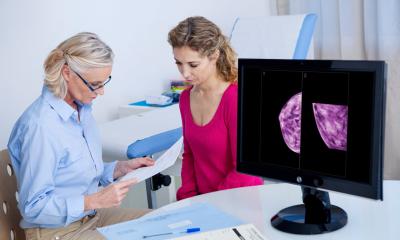Breast Cancer Risk: Genes and Environment Interacting
Scientists from the German Cancer Research Center (DKFZ) in Heidelberg have been the first to prove that genetic and environmental risk factors for breast cancer do not act independently of each other.

Alcohol consumption or the number of births, for example, have an impact on a woman’s risk of developing breast cancer. However, the extent of their impact depends on the genetic makeup of the cells. The scientists have published their results in Plos Genetics.
Whether or not a woman develops breast cancer depends on various factors: Genes play a part, as do the environment and personal behavior. Among the genetic risk factors are the two high-risk genes, BRCA1 and 2. They increase the risk by ten times, but since they are uncommon, they account only for about five percent of all breast cancer cases. Furthermore, comparative genome analyses of breast cancer patients and healthy women have revealed over 20 genetic variants having a moderate influence on the individual breast cancer risk. Environmental and behavioral influences include a woman’s age at her first menstruation, the number of births and duration of breastfeeding, body weight, body height, administration of hormones as contraceptives or to relieve menopausal symptoms, consumption of alcohol, smoking and physical activity.
“No interaction between genetic and environmental risks has been found before,” says Professor Jenny Chang-Claude, head of the Unit of Genetic Epidemiology at DKFZ. “This is probably due to the fact that the number of study subjects was too low and the impact of genetic risk factors is too small.”
In their current work, the DKFZ scientists combined the results of 24 international studies including more than 34,000 breast cancer patients and 41,000 healthy women. “Given so many participants, we were able to identify even slight changes in risk,” says Dr. Stefan Nickels, first author of the study now published. They found that a genetic variant of the CASP8 gene elevated the breast cancer risk by 45% only in women who drank more than 20 grams of alcohol per day. They also found a genetic variant of the LSP 1 gene raising the breast cancer risk in women who gave birth to four or more children by 26%, even though multiple births normally lower the risk for breast cancer. The exact biological mechanisms are still unclear.
“For the first time, we have proven a link between genetic and environmental risk factors for breast cancer. However, the interactions we have found are very moderate and therefore not clinically relevant for risk assessment,” says Jenny Chang-Claude.
Jenny Chang-Claude’s group has contributed to several other articles simultaneously published today in Nature Genetics and Nature Communications. In an unprecedented collaborative project, scientists from over 70 research institutes have identified 49 new genetic risk factors for breast cancer and eight new genetic risk factors for ovarian cancer. The newly identified risk factors are scattered across the whole genome; they are common in the German population and confer risk variations of between three and thirty percent. The new study has more than doubled the number of known genetic factors for these two common gynecological tumors. “It will be interesting to find out how these new genetic risk factors are linked to environmental factors,” Chang-Claude describes her research plans. “This will increase our understanding of how and why breast cancer develops.” The COGS (Collaborative Oncological Gene-environment Study) project was funded by the European Union with €12 million as part of its Seventh Framework Programme as well as by national and local funding sources of the participating research groups.
Stefan Nickels et al.: Evidence of Gene-Environment Interactions between Common Breast Cancer Susceptibility Loci and Established Environmental Risk Factors. PLOS Genetics. 2013. doi:10.1371/journal.pgen.1003284.
02.04.2013











